Abstract
A continuous-culture device was used to select and enrich for microorganisms, from sewage and agricultural runoff, that were capable of using the organophosphorus insecticide parathion as a sole growth substrate. Parathion was dissimilated by the highly acclimated symbiotic activities of Pseudomonas stutzeri, which non-oxidatively and cometabolically hydrolyzed the parathion to ionic diethyl thiophosphate and p-nitrophenol, and P. aeruginosa, which utilized the p-nitrophenol as a sole carbon and energy source. Ionic diethyl thiophosphate was found to be inert to any transformations. Methyl parathion was dissimilated in an analogous way. The device functioned as a chemostat with parathion as the growth-limiting nutrient, and extraordinarily high dissimilation rates were attained for parathion (8 g/liter per day) and for p-nitrophenol (7 g/liter per day). This is the first report of parathion utilization by a defined microbial culture and by symbiotic microbial attack and of dissimilation of an organophosphorus pesticide in a chemostat.
Full text
PDF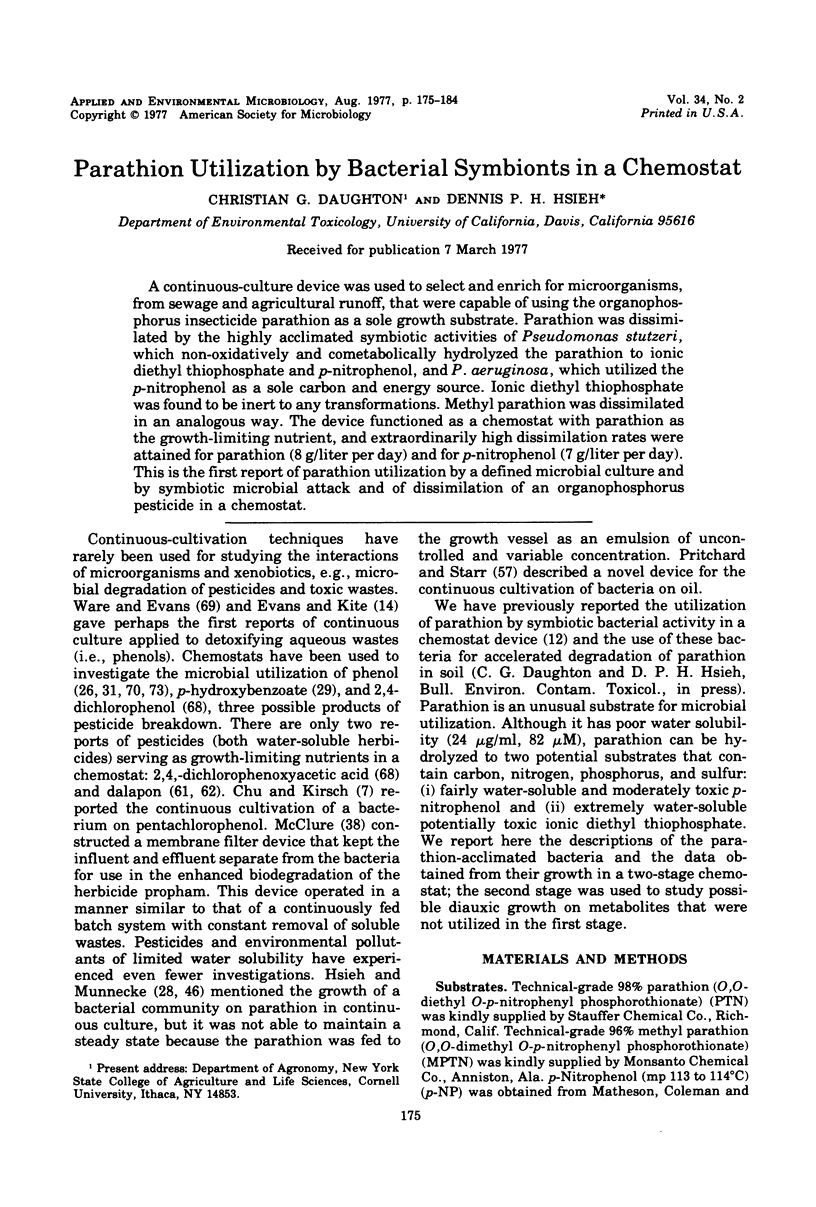
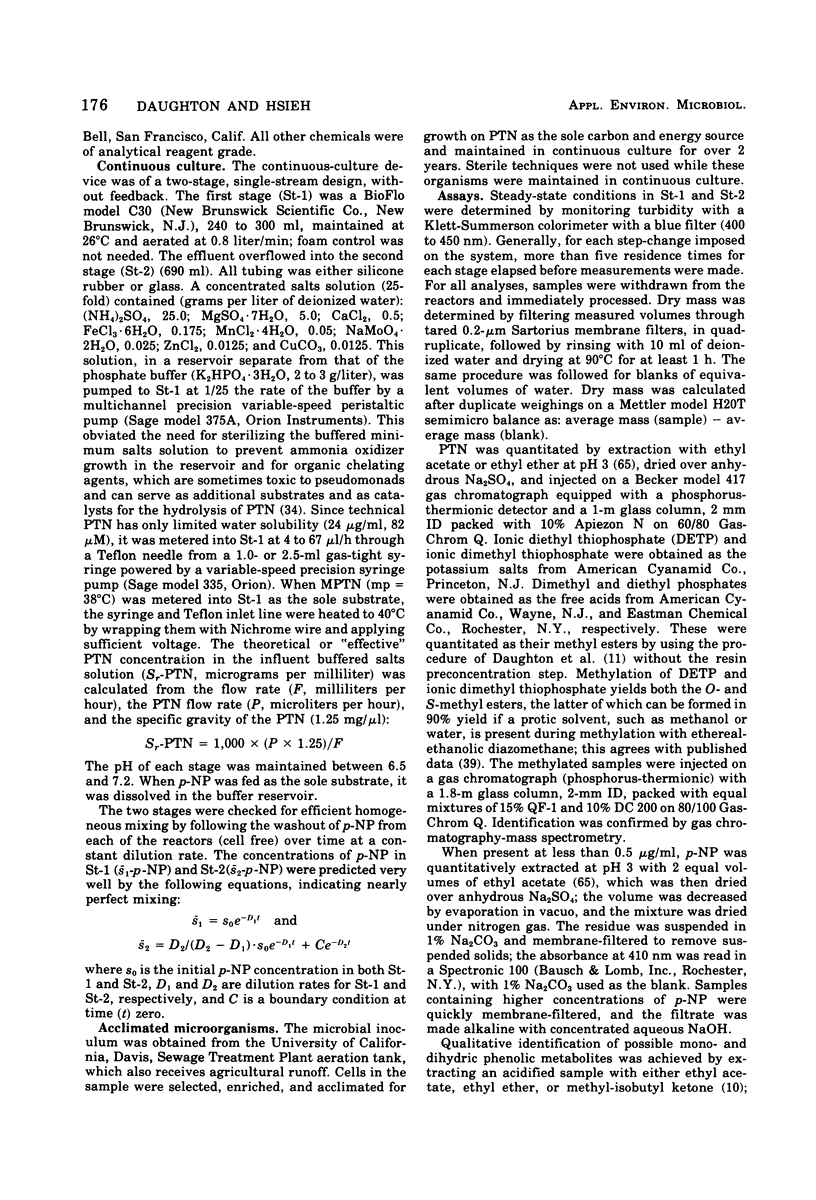
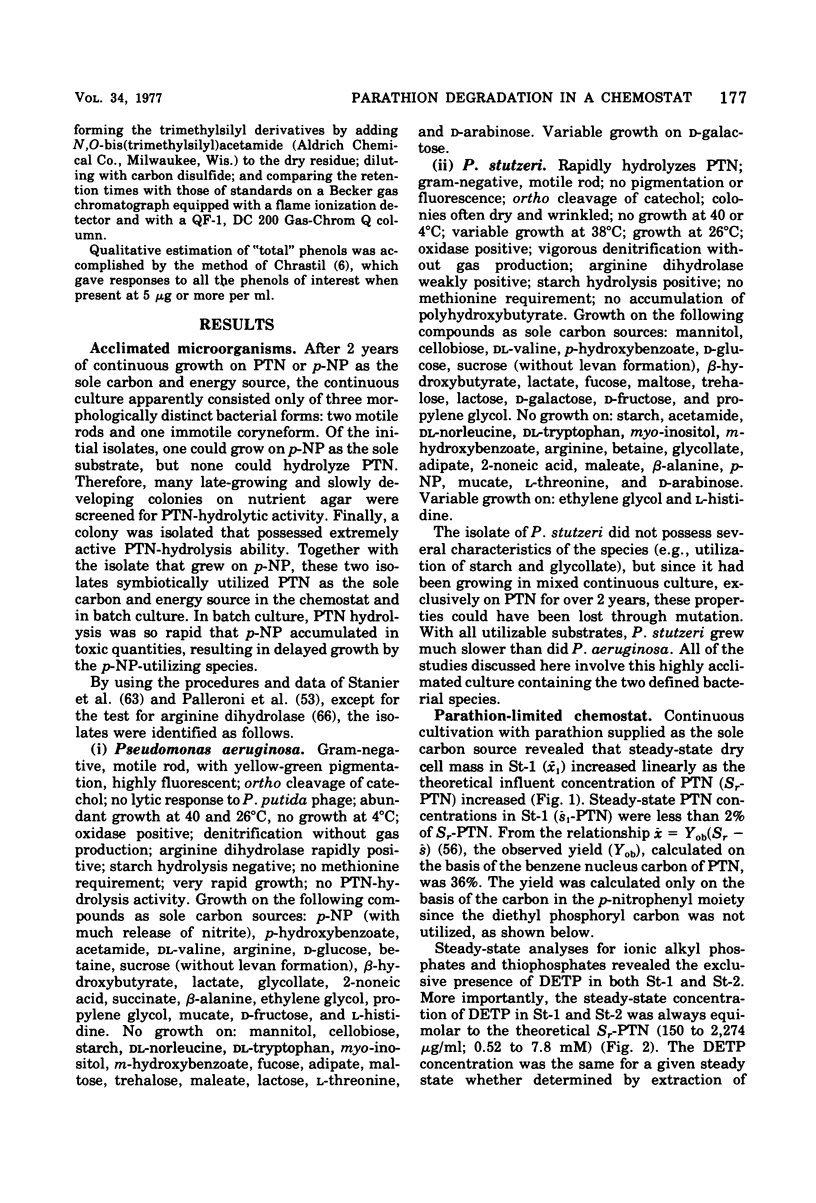
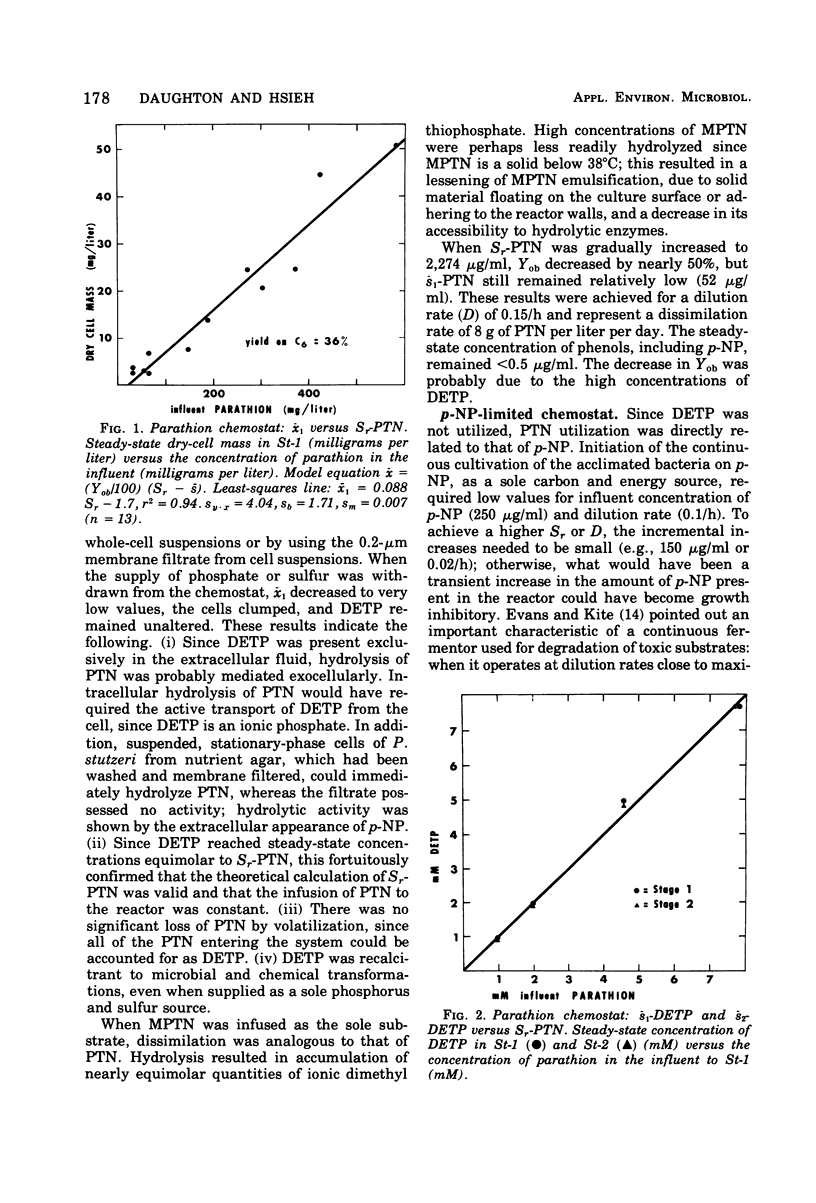
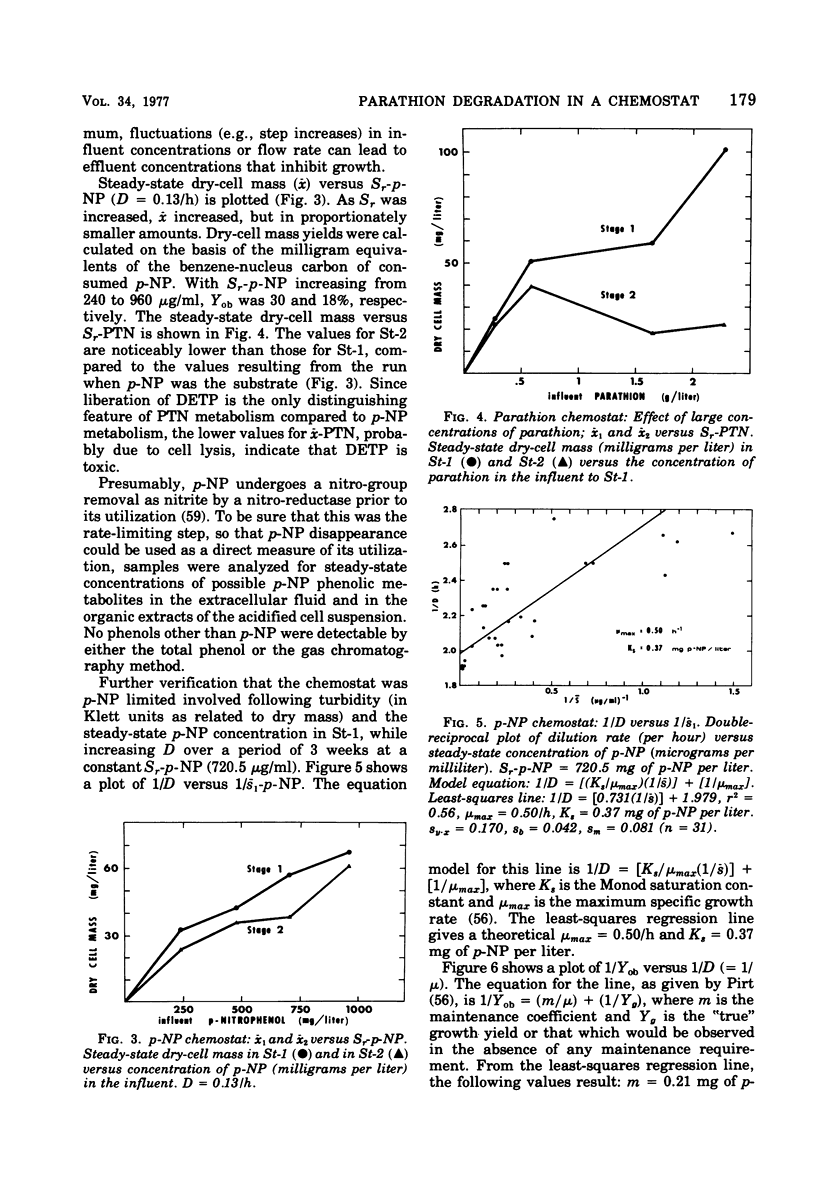
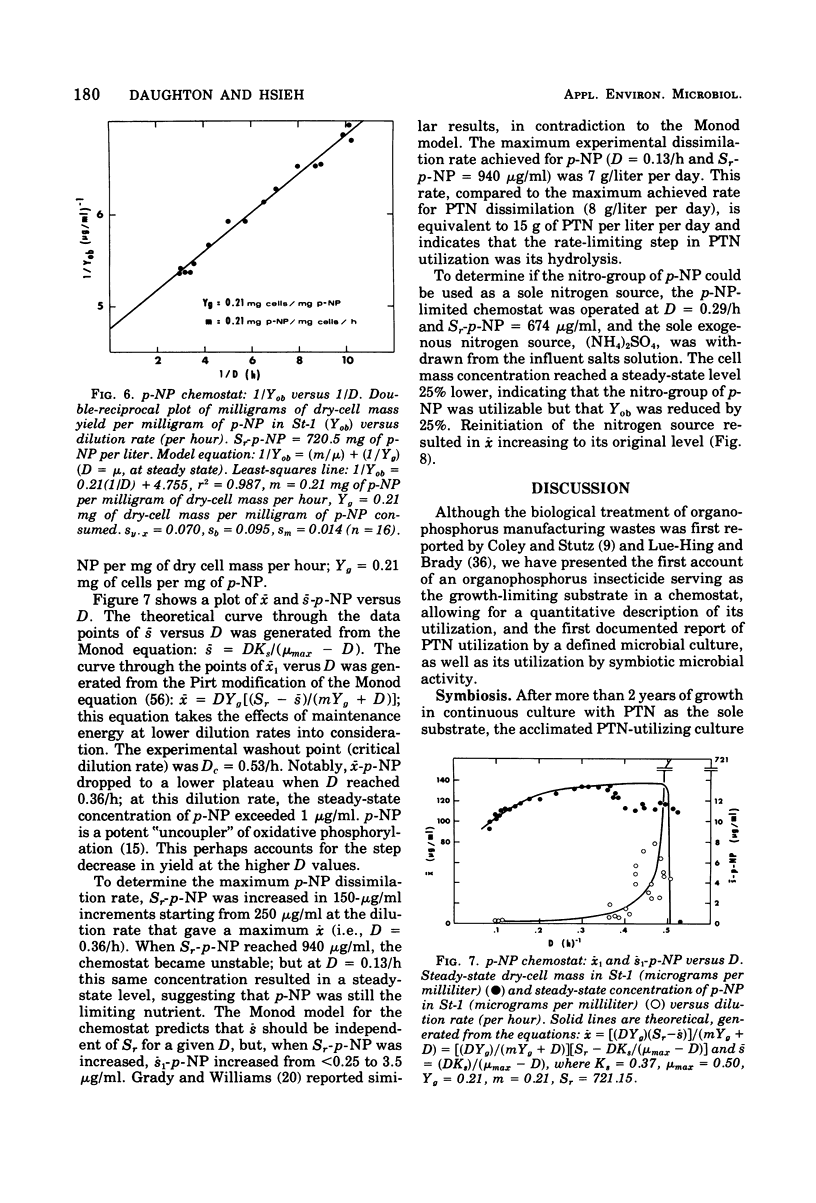
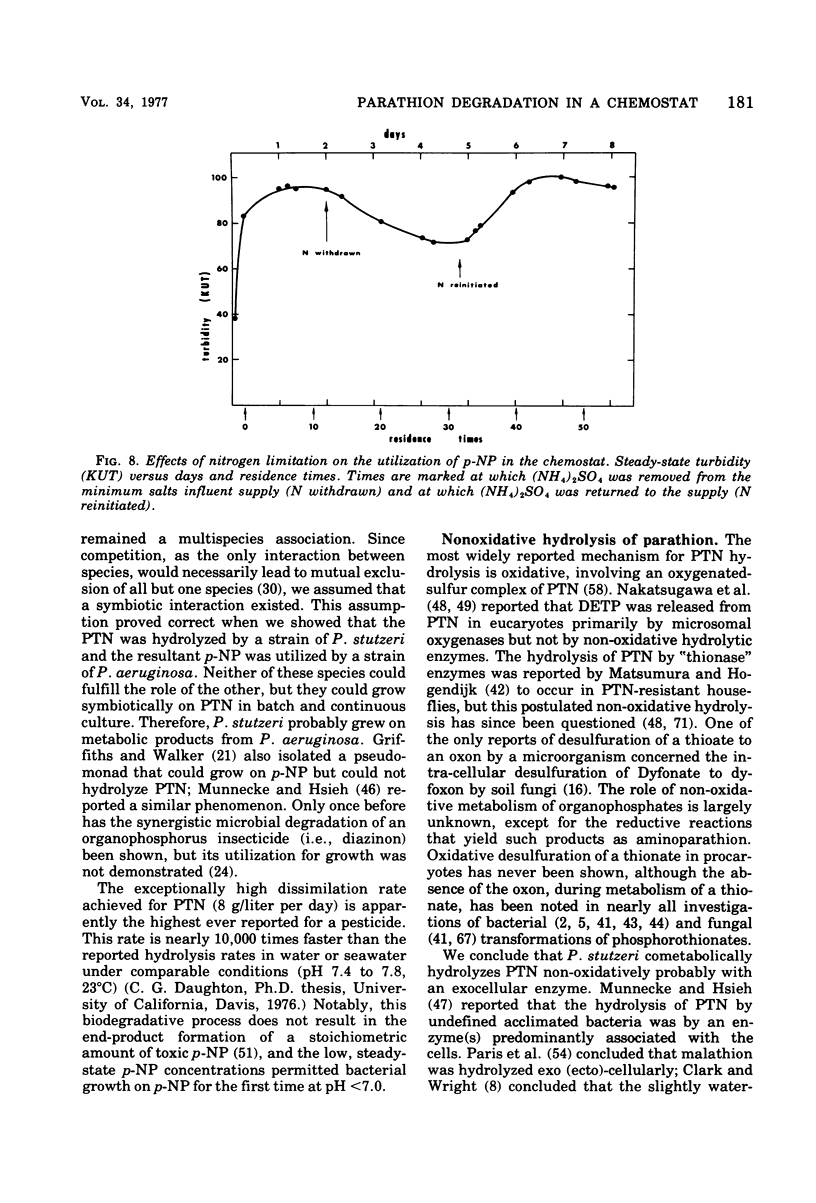
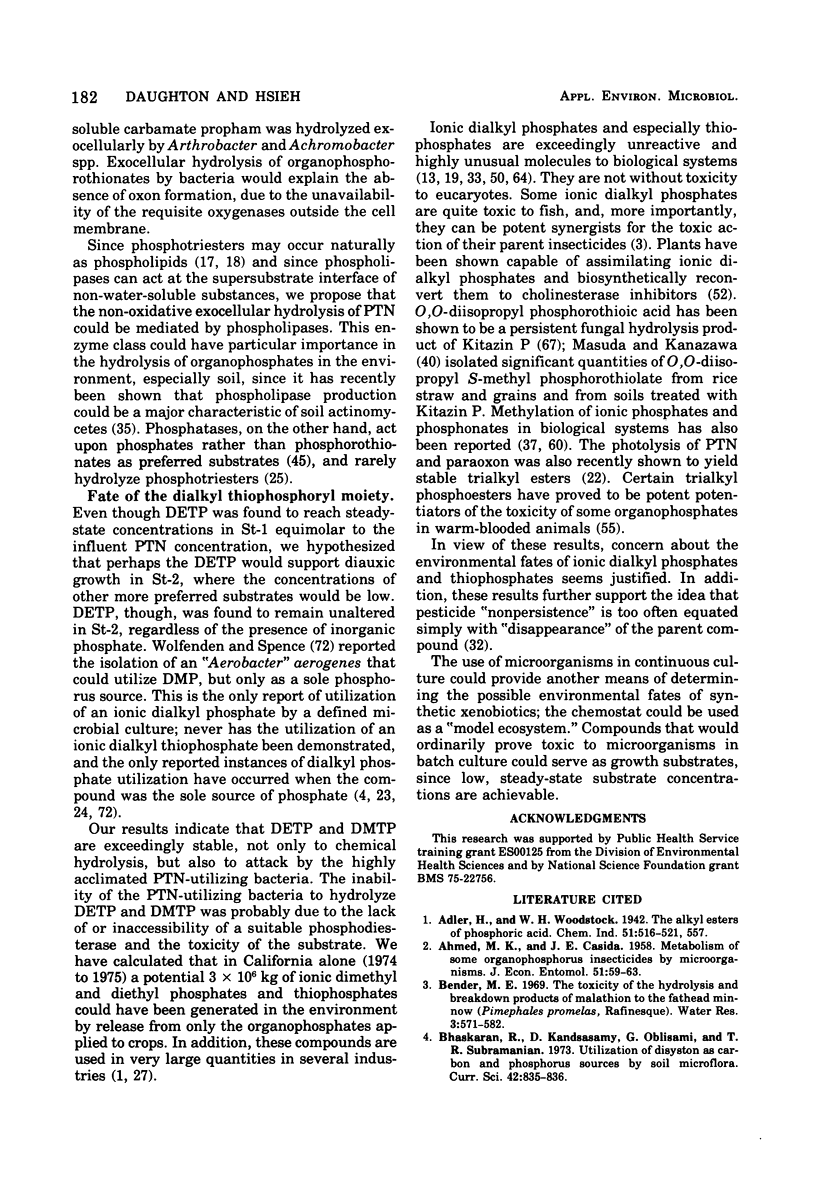
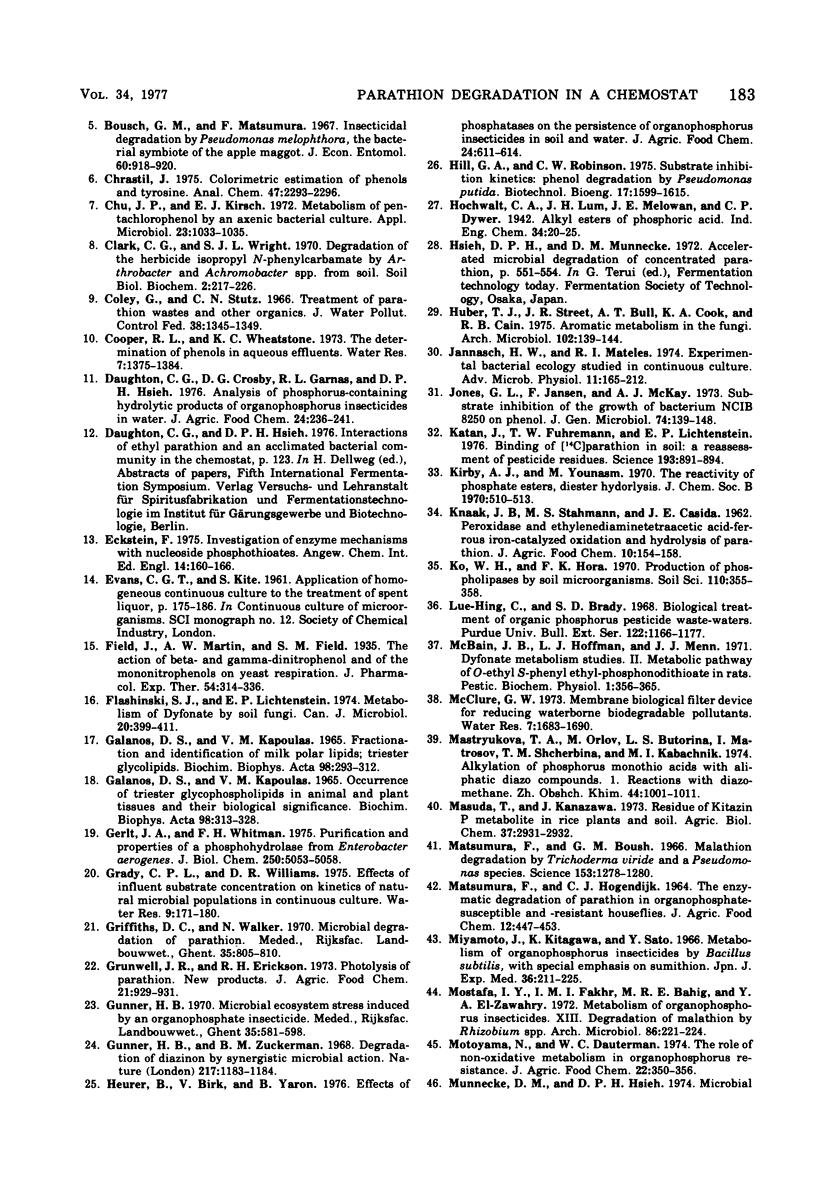

Selected References
These references are in PubMed. This may not be the complete list of references from this article.
- Chrastil J. Colorimetric estimation of phenols and tyrosine. Anal Chem. 1975 Nov;47(13):2293–2296. doi: 10.1021/ac60363a007. [DOI] [PubMed] [Google Scholar]
- Chu J. P., Kirsch E. J. Metabolism of pentachlorophenol by an axenic bacterial culture. Appl Microbiol. 1972 May;23(5):1033–1035. doi: 10.1128/am.23.5.1033-1035.1972. [DOI] [PMC free article] [PubMed] [Google Scholar]
- Coley G., Stutz C. N. Treatment of parathion wastes and other organics. J Water Pollut Control Fed. 1966 Aug;38(8):1345–1349. [PubMed] [Google Scholar]
- Daughton C. G., Crosby D. G., Garnas R. L., Hsieh D. P. Analysis of phosphorus-containing hydrolytic products of organophosphorus insecticides in water. J Agric Food Chem. 1976 Mar-Apr;24(2):236–241. doi: 10.1021/jf60204a015. [DOI] [PubMed] [Google Scholar]
- Eckstein F. Investigation of enzyme mechanisms with nucleoside phosphorothioates. Angew Chem Int Ed Engl. 1975 Mar;14(3):160–166. doi: 10.1002/anie.197501601. [DOI] [PubMed] [Google Scholar]
- Flashinski S. J., Lichtenstein E. P. Metabolism of dyfonate by soil fungi. Can J Microbiol. 1974 Mar;20(3):399–411. doi: 10.1139/m74-061. [DOI] [PubMed] [Google Scholar]
- GALANOS D. S., KAPOULAS V. M. FRACTIONATION AND IDENTIFICATION OF MILK POLAR LIPIDS: TRIESTER GLYCOPHOSPHOLIPIDS. Biochim Biophys Acta. 1965 Apr 5;98:293–312. doi: 10.1016/0005-2760(65)90122-0. [DOI] [PubMed] [Google Scholar]
- GALANOS D. S., KAPOULAS V. M. OCCURRENCE OF TRIESTER GLYCOPHOSPHOLIPIDS IN ANIMAL AND PLANT TISSUES, AND THEIR BIOLOGICAL SIGNIFICANCE. Biochim Biophys Acta. 1965 Apr 5;98:313–328. doi: 10.1016/0005-2760(65)90123-2. [DOI] [PubMed] [Google Scholar]
- Gerlt J. A., Whitman G. J. Purification and properties of a phosphohydrolase from Enterobacter aerogenes. J Biol Chem. 1975 Jul 10;250(13):5053–5058. [PubMed] [Google Scholar]
- Grunwell J. R., Erickson R. H. Photolysis of parathion (O,O-diethyl-O-(4-nitrophenyl)thiophosphate). New products. J Agric Food Chem. 1973 Sep-Oct;21(5):929–931. doi: 10.1021/jf60189a003. [DOI] [PubMed] [Google Scholar]
- Gunner H. B., Zuckerman B. M. Degradation of 'Diazinon' by synergistic microbial action. Nature. 1968 Mar 23;217(5134):1183–1184. doi: 10.1038/2171183a0. [DOI] [PubMed] [Google Scholar]
- Heuer B., Birk Y., Yaron B. Effect of phosphatases on the persistence of organophosphorus insecticides in soil and water. J Agric Food Chem. 1976 May-Jun;24(3):611–614. doi: 10.1021/jf60205a028. [DOI] [PubMed] [Google Scholar]
- Huber T. J., Street J. R., Bull A. T., Cook K. A., Cain R. B. Aromatic metabolism in the fungi. Growth of Rhodotorula mucilaginosa in p-hydroxybenzoate-limited chemostats and the effects of growth rate on the synthesis of enzymes of the 3-oxoadipate pathway. Arch Microbiol. 1975;102(2):139–144. doi: 10.1007/BF00428358. [DOI] [PubMed] [Google Scholar]
- Katan J., Fuhremann T. W., Lichtenstein E. P. Binding of (14C) parathion in soil: a reassessment of pesticide persistence. Science. 1976 Sep 3;193(4256):891–894. doi: 10.1126/science.948750. [DOI] [PubMed] [Google Scholar]
- Matsumura F., Boush G. M. Malathion degradation by Trichoderma viride and a Pseudomonas species. Science. 1966 Sep 9;153(3741):1278–1280. doi: 10.1126/science.153.3741.1278. [DOI] [PubMed] [Google Scholar]
- Miyamoto J., Kitagawa K., Sato Y. Metabolism of organophosphorus insecticides by Bacillus subtilis, with special emphasis on Sumithion. Jpn J Exp Med. 1966 Apr;36(2):211–225. [PubMed] [Google Scholar]
- Mostafa I. Y., Fakhr I. M., Bahig M. R., el-Zawahry Y. A. Metabolism of organophosphorus insecticides. 13. Degradation of malathion by Rhizobium spp. Arch Mikrobiol. 1972;86(3):221–224. doi: 10.1007/BF00425234. [DOI] [PubMed] [Google Scholar]
- Motoyama N., Dauterman W. C. The role of nonoxidative metabolism in organophosphorus resistance. J Agric Food Chem. 1974 May-Jun;22(3):350–356. doi: 10.1021/jf60193a055. [DOI] [PubMed] [Google Scholar]
- Munnecke D. M., Hsieh D. P. Microbial decontamination of parathion and p-nitrophenol in aqueous media. Appl Microbiol. 1974 Aug;28(2):212–217. doi: 10.1128/am.28.2.212-217.1974. [DOI] [PMC free article] [PubMed] [Google Scholar]
- Munnecke D. M., Hsieh D. P. Pathways of microbial metabolism of parathion. Appl Environ Microbiol. 1976 Jan;31(1):63–69. doi: 10.1128/aem.31.1.63-69.1976. [DOI] [PMC free article] [PubMed] [Google Scholar]
- Nakatsugawa T., Tolman N. M., Dahm P. A. Degradation of parathion in the rat. Biochem Pharmacol. 1969 May;18(5):1103–1114. doi: 10.1016/0006-2952(69)90114-2. [DOI] [PubMed] [Google Scholar]
- Nakatsugawa T., Tolman N. M., Dahm P. A. Metabolism of S35-parathion in the house fly. J Econ Entomol. 1969 Apr;62(2):408–411. doi: 10.1093/jee/62.2.408. [DOI] [PubMed] [Google Scholar]
- Neumann H., Boross L., Katchalski E. Hydrolysis of S-substituted monoesters of phosphorothioic acid by alkaline phosphatase from Escherichia coli. J Biol Chem. 1967 Jul 10;242(13):3142–3147. [PubMed] [Google Scholar]
- Palleroni N. J., Doudoroff M., Stanier R. Y., Solánes R. E., Mandel M. Taxonomy of the aerobic pseudomonads: the properties of the Pseudomonas stutzeri group. J Gen Microbiol. 1970 Feb;60(2):215–231. doi: 10.1099/00221287-60-2-215. [DOI] [PubMed] [Google Scholar]
- Pellegrini G., Santi R. Potentiation of toxicity of organophosphorus compounds containing carboxylic ester functions toward warm-blooded animals by some organophosphorus impurities. J Agric Food Chem. 1972 Sep-Oct;20(5):944–950. doi: 10.1021/jf60183a035. [DOI] [PubMed] [Google Scholar]
- Ptashne K. A., Wolcott R. M., Neal R. A. Oxygen-18 studies on the chemical mechanisms of the mixed function oxidase catalyzed desulfuration and dearylation reactions of parathion. J Pharmacol Exp Ther. 1971 Nov;179(2):380–385. [PubMed] [Google Scholar]
- Senior E., Bull A. T., Slater J. H. Enzyme evolution in a microbial community growing on the herbicide Dalapon. Nature. 1976 Oct 7;263(5577):476–479. doi: 10.1038/263476a0. [DOI] [PubMed] [Google Scholar]
- Stanier R. Y., Palleroni N. J., Doudoroff M. The aerobic pseudomonads: a taxonomic study. J Gen Microbiol. 1966 May;43(2):159–271. doi: 10.1099/00221287-43-2-159. [DOI] [PubMed] [Google Scholar]
- Suffet I. H., Faust S. D. The p-value approach to quantitative liquid-liquid extraction of pesticides from water. 1. Organophosphates: choice of pH and solvent. J Agric Food Chem. 1972 Jan-Feb;20(1):52–56. doi: 10.1021/jf60179a039. [DOI] [PubMed] [Google Scholar]
- Tyler J. E., Finn R. K. Growth rates of a pseudomonad on 2,4-dichlorophenoxyacetic acid and 2,4-dichlorophenol. Appl Microbiol. 1974 Aug;28(2):181–184. doi: 10.1128/am.28.2.181-184.1974. [DOI] [PMC free article] [PubMed] [Google Scholar]
- Wase D. A., Hough J. S. Continuous culture of yeast on phenol. J Gen Microbiol. 1966 Jan;42(1):13–23. doi: 10.1099/00221287-42-1-13. [DOI] [PubMed] [Google Scholar]
- Wolfenden R., Spence G. Derepression of phosphomonoesterase and phosphodiesterase activities in Aerobacter aerogenes. Biochim Biophys Acta. 1967 Sep 12;146(1):296–298. doi: 10.1016/0005-2744(67)90099-x. [DOI] [PubMed] [Google Scholar]
- Yang R. D., Humphrey A. E. Dynamic and steady state studies of phenol biodegradation in pure and mixed cultures. Biotechnol Bioeng. 1975 Aug;17(8):1211–1235. doi: 10.1002/bit.260170809. [DOI] [PubMed] [Google Scholar]


